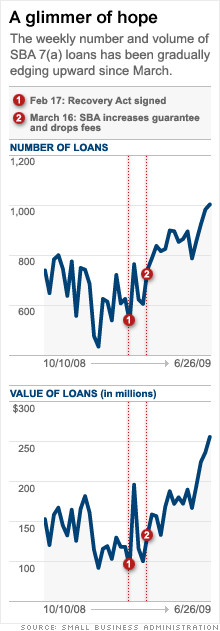Small business lending falls sharply
In its first full quarter since the Recovery Act kicked in, the SBA still backed 30% fewer small business loans than it did a year ago.

NEW YORK (CNNMoney.com) -- Despite emergency stimulus measures, small business lending continues to fall. In the just-ended quarter, the Small Business Administration's flagship program backed 30% fewer loans than it did a year ago, and 55% fewer loans than it did in 2007, before the recession set in.
The numbers bear out the grim reports from business owners who say that credit is dangerously scarce for small firms. The SBA's 7(a) program approved 11,580 loans in the quarter ended June 30, valued at $2.5 billion. That's down from 16,490 loans, worth $3.4 billion, in the same quarter last year.
For the full year to date, the situation is even darker. In the first nine months of its 2009 fiscal year, the SBA has approved roughly half as many loans as it did last year.
With sales slow, many business owners are looking for financing to help them weather the recession, but banks have clamped down on making the risky loans. Additional incentives from the SBA, authorized as part of February's Recovery Act, have helped spur some increased lending but haven't sparked a complete rebound.
Still, SBA officials point to post-stimulus lending trends as a sign that the situation is at least better than it would have otherwise been. Comparing the months before and after the February 17 stimulus signing, the SBA reports a 24% jump in the number of 7(a) loans it has backed.
"They are having an effect," SBA spokesman Mike Stamler said of the SBA's new incentives. On March 16, the agency implemented provisions authorized in (and retroactive to the signing of) February's stimulus bill. The agency has suspended the fees it traditionally charges for its loan guarantees, and has increased the percentage of each loan it will back to up to 90%. If the small business defaults, the government pays the bank back for the guaranteed portion of the loan.
More than 400 lenders that hadn't made a 7(a) loan since at least September have returned to SBA lending since the Recovery Act passed, Stamler said. Last week, the SBA hit a psychological milestone. For the first time since August, it approved more than 1,000 7(a) loans in one week.
One promising sign for borrowers seeking loans: Industry observers say they're seeing more activity on the secondary market. Banks that make SBA-backed loans often resell bundles of those loans to other investors. That market all but froze last fall, cutting many banks off from the capital they needed to keep lending. But in recent months, secondary-market sales have picked up.
"In addition to help from higher guarantees and fee reductions, the price being paid for SBA loans in the secondary market is increasing and helping fuel increased SBA loan volume at many community banks," said Paul G. Merski, chief economist for the Independent Community Bankers of America. "Some of our community bank members are making more SBA loans this year than last."
Temecula Valley Bancorp (TMCV) in California, which was a top-10 SBA lender last year, dropped out of the SBA program in January because of the poor secondary market conditions. SBA division head Stephanie Bitters said Temecula has noticed the improvement in the market and said her bank hopes to participate again later this year. ![]()
Business owners cut to the bone
Emergency small business loans off to a slow start
SOS: Send loans now
Specialist lenders profit as big banks pull back
-
The Cheesecake Factory created smaller portions to survive the downturn. Play
-
A breeder of award-winning marijuana seeds is following the money and heading to the U.S. More
-
Most small businesses die within five years, but Amish businesses have a survival rate north of 90%. More
-
The 10 most popular franchise brands over the past decade -- and their failure rates. More
-
These firms are the last left in America making iconic products now in their twilight. More









